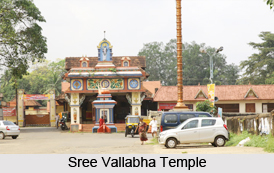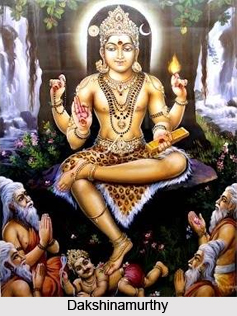 Sreevallabha Temple was built in the silent and picturesque land on the banks of Manimala river. This icon of Kerala temple architecture covers an area of 8.5 acres and ranks first among the temples of old Travancore state in terms of area inside the compound wall.
Sreevallabha Temple was built in the silent and picturesque land on the banks of Manimala river. This icon of Kerala temple architecture covers an area of 8.5 acres and ranks first among the temples of old Travancore state in terms of area inside the compound wall.
Surrounding of Sreevallabha Temple
Sreevallabha Temple is surrounded on all sides by 12 feet, tall 566 feet long, 4.5 feet thick red granite compound walls with a two-storied gopuram (gate tower) on each side. This huge wall was built in 57 BC and is believed that it was completed in a single night by bhoothagana (servants) of The Lord. Outside eastern wall a big pond covering 1.5 acres is seen in north-eastern direction with a copper flagstaff on its southern bank. A platform for performing kathakali is seen just in front of the eastern entrance. Inside the wall pradakshina veethi or outer circumambulation path is seen with four small aankottils (places where the deity is taken out and kept for worship inside temple wall) and a big one on south-eastern corner. South-east to this is an oottupura or dining hall is seen which is built in all other temples only on northern side and this is unique to Sreevallabha temple only.
Complex of Sreevallabha Temple
The temple auditorium and administrative offices can be seen next to this. Smaller shrines for lord Ganapathy and Ayyappan and another auditorium are seen in south-western side. The position of kshethra palan or temple guard which is strictly built in all temples on northern side is found here just in front of Ganapathy"s shrine i.e. on southern side which is also another peculiarity found here and nowhere else.
Holy Tress in Sreevallabha Temple
The sacred fig and mango trees beneath which sage Durvasa meditated is found near Ayyappan shrine. Just outside the western gopuram, Sankaramangalth Illam where Sreedevi Antharjanam lived is seen well preserved for the initiation of any pooja in the temple. Northern gopuram is closed always and is opened only for Uthra Sreebali festival. North east to pradakshina veethi, a self originated pond called Jalavanthi or Khandakarna theerthem which is believed to contain 64 hidden idols of the Lord. It is for only the use of priests. Spot where sage Vedavyasa and sage Durvasa disappeared is found on its eastern bank and resting building for the priests on southern side. North to the temple a roofless shrine dedicated to kurayappa swamy is seen. No pooja is done here, but only banana as naivedyam. The bahir bali vrutham or outer circle of sacrificial stones is built inner to bahir pradakshina veethi. The temple koothambalam (stage) was destroyed by fire in 1915.
Cynosure of Sreevallabha Temple
The most highlighted construction of the temple is the Garuda dhvaja sthambam or flagstaff of Garuda, the majestic eagle mount of Lord Vishnu. This monolithic structure is completely built from black granite and elevated to 53.5 feet above the ground with its lower end touching water table. Constructed in 57 BC, Sreevallabha Temple was also built in a single night along with the outer wall. And an amazing fact is that no black granites can be found in an area ten miles around the temple. A 3 feet massive idol of Garuda is placed on the top of it facing the main sanctum. Since this flagstaff started slanting and reached its current position, a three tiered copper roofed construction has been made all around it to prevent further slanting. West to this, currently used golden flagstaff can be seen. West to the third flagstaff, balikkalpura (room of the major sacrificial stone) is built around a ten feet tall balipeetha (main sacrificial stone). Vallyambalam (building attached to naalambalam at its main entrance and between naalambalam and balikkalpura) is a double storied copper sheet roofed building standing on 16 stone pillars. These pillars and the roof are noted for their exquisite and minute carvings demonstrating the excellence of those who built it.
Central Corridor of Sreevallabha Temple
The central corridor of Sreevallabha Temple leads to naalambalam (double walled building constructed around sanctum-sanctorum at a distance) with thidappalli or holy kitchen, navakappura or room for navaka pooja etc.
Naalambalam of Sreevallabha Temple
The 150 feet long, 11 feet Broad square naalambalam is completely made out of black stones and supported by 54 stone pillars beautifully carved with the image of a Salabhanjika on each. Outside naalambalam, a deepasala (galaxy of bronze lamps) is built on teak wood. The western part of naalambalam is adorned with some murals and a small shrine for vadakkum thevar i.e., the idols of Vishnu, Shiva, Parvati, Murugan and Nrithaganapathy worshipped by Sreedevi Antherjanam. Two namaskara mandapam (prostration building) are built against both doors of Sreekovil (sanctum-sanctorum) and only Brahmins are allowed there. The eastern mandapam is 24 feet long square building with copper sheeted roof and stand on 12 wooden and 4 stone pillars. All these are well known for their fine carvings. The western mandapam is small and also square shaped. The circular, copper roofed, golden domed sreekovil is adorned with finely etched murals of Matsya, Kaaliyamardana, Kurma, Dakshinamurthy, Varaha, Venu Gopala, Maha Ganapathy, Narasimha, Vamana, Sudarshana, Parashurama, Sree Rama, Purusha Sukta, Balarama, Sreekrishna, Lakshmi, Kalki and Garuda in clockwise manner.











